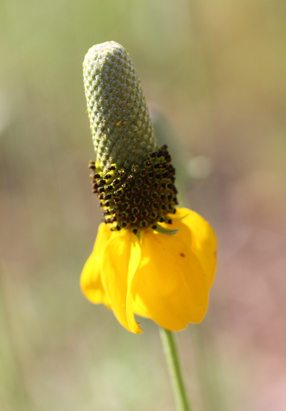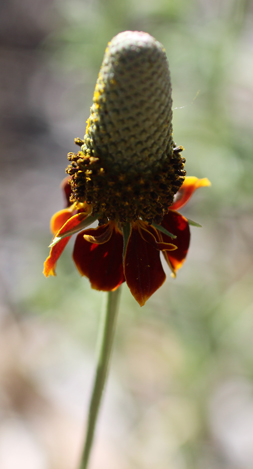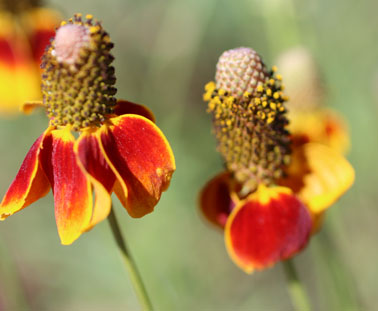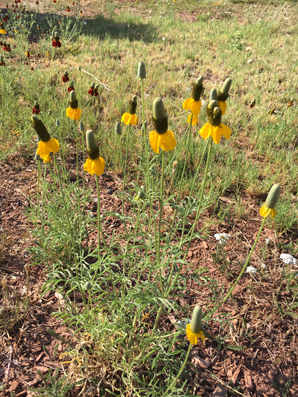
Location
Outside Visitor Center (N35D33'00.809 X W105D41'10.631)
Flowers first observed: 6/21/17
The Plant w/Flowers
The Flower
 |
 |
 |
Yellow |
Red |
Multi-color |
Distribution
"Found in pinyon-juniper and ponderosa pine woodlands, prairies, grasslands, and disturbed areas, from 4,000-7,500 ft (1219-2286 m); flowers March-November. Distribution: s CAN, south primarily through the Great Plains to n MEX." (SEINet)
Description
"Perennial herbs, 20-100 cm tall, from a taproot; stems erect, hirsute-strigose and glandular. Leaves: Basal leaves petiolate, often withering at maturity; stem leaves alternate, often sessile; blades 2-15 cm long to 1-6 cm wide, pinnately lobed with 3-14 lobes, the lobes oblanceolate to linear, 1-16 mm wide, the faces hirsute, gland-dotted. Flowers: Flower heads showy, radiate with yellow to maroon rays and tall columnar receptacles; flower heads held well above the leaves on long leafless peduncles, 6-40 cm long, with prominent tan ribs; involucres spreading-campanulate to rotate, 1 cm wide, the bracts (phyllaries) 2 series, outer ones linear, 4-14 mm long, inner ones lanceolate-ovate, 1-3 mm long; ray florets 4-12 per flower head, the laminae (ray petals) yellow, purplish-yellow, maroon, or bicolored, lanceolate-ovate to elliptic-oblanceolate, 1-3 cm long and 4-17 mm wide; receptacles columnar, 1-5 cm tall and about 1 cm wide; disc florets 200-400 per flower head, covering the columnar receptacle, the corollas greenish yellow, often purplish below; palea subtending the disc florets white-pubescent, making the disc florets appear greenish gray before they open. Fruits: Achenes oblong, 1-3 mm long, the upper margins and apices sometimes ciliate; sometimes topped with a pappus of 1-2 tan-colored toothlike projections." (SEINet)
Ethnobotanical Uses
Food:
"Dakota Beverage Leaves used to make a hot, tea-like beverage. Oglala Beverage Leaves and cylindrical heads used to make a tea-like beverage." (Moerman 469)
Medical:
"Used to wean children off breast milk, and medicinally to treat pain, poison ivy rash, snake bites, chest pains, wounds, stomachaches, coughs, and fever; also used ceremonially." (SEINet)
"Cheyenne Analgesic Decoction of leaves and stems used as wash for pain. Dermatological Aid Decoction of leaves and stems used for poison ivy rash. Snakebite Remedy Decoction of leaves and stems used as wash to draw our poison of a rattlesnake's bite. --- Dakota Analgesic Flowers used for chest pains and other ailments. Dermatological Aid Flowers used for wounds. Panacea Flowers used for chest pains and other ailments. Keres, Western Gynecological Aid Crushed leaves rubbed on mothers' breast to wean child. Lakota Analgesic Infusion of plant tops taken for stomachaches. Veterinary Aid Plant given to horses for urinary problems. Navajo, Ramah Febrifuge Cold infusion used for fever. Veterinary Aid Cold infusion given to sheep that are 'out of their minds.' Zuni Emetic Infusion of whole plant taken as an emetic." (Moerman 469)
Other Uses:
"Lakota Cooking Tools Plant top used as a nipple." (Moerman 469)
Internet Links
